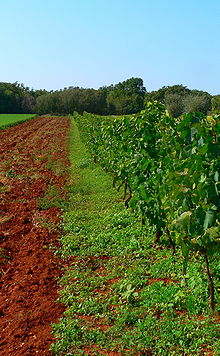Terra rossa (soil)

Terra rossa ( Italian for "red soil") is a type of red clay soil produced by the weathering of limestone. When limestone weathers, the clay contained in the rocks is left behind, along with any other non-soluble rock material. Under oxidizing conditions, when the soils are above the water table, iron oxide (rust) forms in the clay. This gives it a characteristic red to orange colour.
Terra rossa is typically found in regions with a Mediterranean climate [1][citation needed] but can also be seen elsewhere, for example in Prince Edward Island, Canada.
Compared to most clay soils, terra rossa has surprisingly good drainage characteristics. This makes it a popular soil type for wine production. Among other wine regions, it is found in La Mancha in Spain and Coonawarra in Australia.[1]
Red Mediterranean
In pedology, red Mediterranean soil, also known as terra rossa (Italian for "red soil") is a soil classification that has been formally superseded by the formal classifications of systems such as the FAO soil classification, but that is still in common use. The terra rossa classification was still, as of 1997, a part of the national soil classifications of countries such as Israel and Italy. The UNESCO/FAO World map equivalents are the chromic luvisols (a sub-order of the luvisols), and the USDA soil taxonomy equivalent is the rhodustalfs (a sub-order of the ustalfs).[2]
The classification denotes red-coloured soils (sometimes called "red rendzinas") which develop in or on the karstic landscape of the limestones of the Miocene and earlier periods, as well as calcretes in regions where the modern Mediterranean climate is predominant. The most accelerated development of red Mediterranean soils occurred from the Miocene to the Late Pleistocene, due to the large amount of climate fluctuation in those periods.[3][4]
Terra rossa occurs in areas where heavy rainfall dissolves carbon from the calcium carbonate parent rock and silicates are leached out of the soil to leave residual deposits that are rich in iron hydroxides, the cause of the red colour. Such areas are usually depressions within the limestone, or areas where the vegetation is garrigue (low-lying scrub).[2][4]
References
- ^ a b Oxford Companion to Wine (2nd Ed, 1999) at winepros.com.au: terra rossa, accessed on July 9, 2008
- ^ a b Harriet D. Allen (2001). Mediterranean Ecogeography. Pearson Education. pp. 79–81. ISBN 0-582-40452-5.
- ^ I. Atalay (1998). "Paleoenvironmental conditions of the Late Pleistocene and Early Holocene in Anatolia, Turkey". In A. S. Alsharhan; K. W. Glennie; G. L. Whittle; C. G. St. C. Kendall (eds.). Quaternary Deserts & Climatic Change: Proceedings of an International conference on Quaternary Deserts and Climatic Change at Al Ain, UAE, December 9–11, 1995. Taylor & Francis. p. 229. ISBN 9054105976.
{{cite conference}}: Unknown parameter|booktitle=ignored (|book-title=suggested) (help) - ^ a b David Waugh (2000). Geography: An Integrated Approach. Nelson Thornes. p. 274. ISBN 0-17-444706-X.
Further reading
- Randall J. Schaetzl; Sharon Anderson (2005). "terra rossa soils of the Mediterranean". Soils: Genesis and Geomorphology. Cambridge University Press. p. 201. ISBN 0-521-81201-1.
